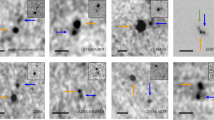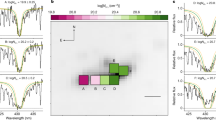Abstract
Lyman-α blobs (LABs) are spatially extended nebulae of emission in the Lyman-α (Lyα) line of hydrogen, seen at high redshifts1,2, and most commonly found in the dense environment of star-forming galaxies3,4. A recent study showed that nearly 100% of the sky is covered by Lyα emission around high-redshift galaxies5,6,7. The origin of Lyα emission in the LABs is still unclear and under debate8. It may be powered by photoionization involving galactic superwinds/outflows, resonant scattering of Lyα photons from starbursts or active galactic nuclei9,10,11,12,13,14,15,16, or by cooling radiation from cold streams of gas accreting onto galaxies17,18, as demonstrated by recent simulations19. Here we analyse the gas kinematics within a LAB, providing rare observational evidence for infalling gas. This is consistent with the release of gravitational accretion energy as cold streams radiate Lyα photons. It also provides direct evidence for possible cold streams feeding the central galaxies. The mass of the infalling gas is not important in comparison to the gas mass consumed by star formation, and is also not the major powering source of Lyα emission, but it hints at another mechanism to explain the origin of the extended Lyα emission around young galaxies.
This is a preview of subscription content, access via your institution
Access options
Access Nature and 54 other Nature Portfolio journals
Get Nature+, our best-value online-access subscription
$29.99 / 30 days
cancel any time
Subscribe to this journal
Receive 12 digital issues and online access to articles
$119.00 per year
only $9.92 per issue
Buy this article
- Purchase on Springer Link
- Instant access to full article PDF
Prices may be subject to local taxes which are calculated during checkout


Similar content being viewed by others
Data availability
All the raw data used in this study are available at the ALMA Science Archive (https://almascience.nao.ac.jp/aq/) under programme ID 2015.1.00952.S, at the ESO Science Archive Facility (http://archive.eso.org/eso/eso_archive_main.html) under programme IDs 082.A-0846 and 297.A-5059, and at the NASA/IPAC Infrared Science Archive (https://irsa.ipac.caltech.edu/applications/Spitzer/SHA) under programme ID GO-3699. The data that support the plots within this paper and other findings of this study are available from the corresponding author upon reasonable request.
Code availability
To fit the Lyα line profile, we developed our own code by adopting a simple contracting model that inflating gas is uniformly located in a thin shell of neutral gas and that Lyα radiation from the central source is scattered by the hydrogen atom in the shell. Codes used in this study are not publicly released yet but are available from the corresponding author on reasonable request.
References
Francis, P. J. et al. A group of galaxies at redshift 2.38. Astrophys. J. 457, 490–499 (1996).
Steidel, C. C. et al. Lyα imaging of a proto-cluster region at z = 3.09. Astrophys. J. 532, 170–182 (2000).
Matsuda, Y. et al. A subaru search for Lyα blobs in and around the protocluster region at redshift z = 3.1. Astron. J. 128, 569–584 (2004).
Matsuda, Y. et al. Diffuse Lyα haloes around Lyα emitters at z = 3: do dark matter distributions determine the Lyα spatial extents? Mon. Not. R. Astron. Soc. 425, 878–883 (2012).
Wisotzki, L. et al. Nearly all the sky is covered by Lyman-α emission around high-redshift galaxies. Nature 562, 229–232 (2018).
Laursen, P., Sommer-Larsen, J., Milvang-Jensen, B., Fynbo, J. P. U. & Razoumov, A. O. Lyα-emitting galaxies in the epoch of reionization. Astron. Astrophys. 627, A84 (2019).
Smith, A. et al. The physics of Lyα escape from high-redshift galaxies. Mon. Not. R. Astron. Soc. 484, 39–59 (2019).
Yajima, H., Li, Y. & Zhu, Q. Extended Lyα emission from interacting galaxies at high redshifts. Astrophys. J. 773, 151 (2013).
Ao, Y. et al. What powers Lyα blobs? Astron. Astrophys. 581, A132 (2015).
Ao, Y. et al. Deep submillimeter and radio observations in the SSA22 field. I. Powering sources and Lyα escape fraction of Lyα blobs. Astrophys. J. 850, 178 (2017).
Cantalupo, S. in Gas Accretion onto Galaxies (eds Fox A. & Davé, R.) 195–220 (Springer, 2017).
Cen, R. & Zheng, Z. The nature of Lyα blobs: powered by extreme starbursts. Astrophys. J. 775, 112 (2013).
Colbert, J. W. et al. Ultraviolet-bright, high-redshift ultraluminous infrared galaxies. Astrophys. J. 637, L89–L92 (2006).
Geach, J. E. et al. The Chandra deep protocluster survey: Lyα blobs are powered by heating, not cooling. Astrophys. J. 700, 1–9 (2009).
Geach, J. E. et al. ALMA observations of Lyα blob 1: halo substructure illuminated from within. Astrophys. J. 832, 37 (2016).
Zheng, Z., Cen, R., Weinberg, D., Trac, H. & Miralda-Escudé, J. Extended Lyα emission around star-forming galaxies. Astrophys. J. 739, 62 (2011).
Nilsson, K. K., Fynbo, J. P. U., Moller, P., Sommer-Larsen, J. & Ledoux, C. A Lyα blob in the goods south field: evidence for cold accretion onto a dark matter halo. Astron. Astrophys. 452, L23–L26 (2006).
Smith, D. J. B. & Jarvis, M. J. Evidence for cold accretion onto a massive galaxy at high redshift? Mon. Not. R. Astron. Soc. 378, L49–L53 (2007).
Dijkstra, M. & Loeb, A. Lyα blobs as an observational signature of cold accretion streams into galaxies. Mon. Not. R. Astron. Soc. 400, 1109–1120 (2009).
Palunas, P., Teplitz, H. I., Francis, P. J., Williger, G. M. & Woodgate, B. E. The distribution of Lyα -emitting galaxies at z = 2.38. Astrophys. J. 602, 545–554 (2004).
Zheng, Z. & Miralda-Escudé, J. Monte Carlo simulation of Lyα scattering and application to damped Lyα systems. Astrophys. J. 578, 33–42 (2002).
Dijkstra, M., Haiman, Z. & Spaans, M. Lyα radiation from collapsing protogalaxies. II. Observational evidence for gas infall. Astrophys. J. 649, 37 (2006).
Faucher-Giguère, C.-A., Kereš, D., Dijkstra, M., Hernquist, L. & Zaldarriaga, M. Lyα cooling emission from galaxy formation. Astrophys. J. 725, 633–657 (2010).
Hayes, M., Scarlata, C. & Siana, B. Central powering of the largest Lyα nebula is revealed by polarized radiation. Nature 476, 304–307 (2011).
Cen, R. Evolution of cold streams and the emergence of the Hubble sequence. Astrophys. J. 789, L21 (2014).
Dekel, A. et al. Cold streams in early massive hot haloes as the main mode of galaxy formation. Nature 457, 451–454 (2009).
Agertz, O., Teyssier, R. & Moore, B. The formation of disc galaxies in a ΛCDM universe. Mon. Not. R. Astron. Soc. 410, 1391–1408 (2011).
Dekel, A. & Birnboim, Y. Galaxy bimodality due to cold flows and shock heating. Mon. Not. R. Astron. Soc. 368, 2–20 (2006).
Nelson, D. et al. Moving mesh cosmology: tracing cosmological gas accretion. Mon. Not. R. Astron. Soc. 429, 3353–3370 (2013).
Martin, D. C. et al. A giant protogalactic disk linked to the cosmic web. Nature 524, 192–195 (2015).
Erb, D. K., Bogosavljević, M. & Steidel, C. C. Filamentary large-scale structure traced by six Lyα blobs at z = 2.3. Astrophys. J. 740, L31 (2011).
Umehata, H. et al. Gas filaments of the cosmic web located around active galaxies in a protocluster. Science 366, 97–100 (2019).
Yajima, H., Li, Y., Zhu, Q. & Abel, T. Cold accretion in early galaxy formation and its Lyα signatures. Astrophys. J. 801, 52 (2015).
Zheng, Z. & Wallace, J. Anisotropic Lyman-alpha emission. Astrophys. J. 794, 116 (2014).
Kimm, T., Cen, R., Devriendt, J., Dubois, Y. & Slyz, A. Towards simulating star formation in turbulent high-z galaxies with mechanical supernova feedback. Mon. Not. R. Astron. Soc. 451, 2900–2921 (2015).
Vernet, J. et al. X-shooter, the new wide band intermediate resolution spectrograph at the ESO Very Large Telescope. Astron. Astrophys. 536, A105 (2011).
Freudling, W. et al. Automated data reduction workflows for astronomy. The eso reflex environment. Astron. Astrophys. 559, A96 (2013).
Colbert, J. W. et al. Polycyclic aromatic hydrocarbon emission within Lyα blobs. Astrophys. J. 728, 59 (2011).
Carnall, A. C., McLure, R. J., Dunlop, J. S. & Davé, R. Inferring the star formation histories of massive quiescent galaxies with BAGPIPES: evidence for multiple quenching mechanisms. Mon. Not. R. Astron. Soc. 480, 4379–4401 (2018).
Rodrigo, C., Solano, E. & Bayo, A. The SVO Filter Profile Service (IVOA Documents, 2012); http://ivoa.net/documents/Notes/SVOFPS/index.html
Rodrigo, C. & Solano, E. The Filter Profile Service Access Protocol (IVOA Documents, 2013); http://ivoa.net/documents/Notes/SVOFPSDAL/index.html
Kennicutt, R. C. & Evans, N. J. Star formation in the Milky Way and nearby galaxies. Annu. Rev. Astron. Astrophys. 50, 531–608 (2012).
Lu, N. et al. Measuring star formation rate and far-infrared color in high-redshift galaxies using the CO(7–6) and [N ii] 205 μm lines. Astrophys. J. 802, L11 (2015).
Carilli, C. L. & Walter, F. Cool gas in high-redshift galaxies. Annu. Rev. Astron. Astrophys. 51, 105–161 (2013).
Yang, C. et al. Molecular gas in the herschel-selected strongly lensed submillimeter galaxies at \(z\sim 2-4\) as probed by multi-J CO lines. Astron. Astrophys. 608, A144 (2017).
Downes, D. & Solomon, P. M. Rotating nuclear rings and extreme starbursts in ultraluminous galaxies. Astrophys. J. 507, 615–654 (1998).
Yang, Y., Zabludoff, A., Jahnke, K. & Davé, R. The properties of Lyα nebulae: gas kinematics from nonresonant lines. Astrophys. J. 793, 114 (2014).
Gronke, M., Bull, P. & Dijkstra, M. A systematic study of Lyα transfer through outflowing shells: model parameter estimation. Astrophys. J. 812, 123 (2015).
Gurung-López, S., Orsi, Á. A. & Bonoli, S. FLAREON: a fast computation of Lyα escape fractions and line profiles. Mon. Not. R. Astron. Soc. 490, 733–740 (2019).
Vanzella, E. et al. Illuminating gas inflows/outflows in the MUSE deepest fields: Lyα nebulae around forming galaxies at z ≃ 3.3. Mon. Not. R. Astron. Soc. 465, 3803–3816 (2017).
Gronke, M. Modeling 237 Lyα spectra of the MUSE-Wide survey. Astron. Astrophys. 608, A139 (2017).
Acknowledgements
Y.A. acknowledges financial support by NSFC grants 11988101, 11933011 and 11373007. J.E.G. is supported by a Royal Society University Research Fellowship. This paper makes use of the following ALMA data: ADS/JAO.ALMA#2015.1.00952.S. ALMA is a partnership of ESO (representing its member states), NSF (USA) and NINS (Japan), together with NRC (Canada), NSC and ASIAA (Taiwan), and KASI (Republic of Korea), in cooperation with the Republic of Chile. The Joint ALMA Observatory is operated by ESO, AUI/NRAO and NAOJ. This research was based on observations collected at the European Organisation for Astronomical Research in the Southern Hemisphere under ESO programme IDs 297.A-5059(A) and 082.A-0846(B). This research has made use of the SVO Filter Profile Service (http://svo2.cab.inta-csic.es/theory/fps/) with support from the Spanish MINECO through grant AyA2014-55216.
Author information
Authors and Affiliations
Contributions
Y.A. is the principal investigator of the ALMA and VLT/X-shooter observing proposals. Y.A. reduced the data and wrote the initial manuscript. Z.Z. conducted the data analysis with the SED modelling, drafted the interpretation and discussion of the Lyα emission and polished the manuscript. S.N. and Z.Z. performed the Lyα spectrum fitting with an infalling shell model. C.H. helped to polish the manuscript. All authors discussed and commented on the manuscript.
Corresponding author
Ethics declarations
Competing interests
The authors declare no competing interests.
Additional information
Peer review information Nature Astronomy thanks Aaron Smith and the other, anonymous, reviewer(s) for their contribution to the peer review of this work.
Publisher’s note Springer Nature remains neutral with regard to jurisdictional claims in published maps and institutional affiliations.
Supplementary information
Supplementary Information
Supplementary Figs. 1–5 and Table 1.
Rights and permissions
About this article
Cite this article
Ao, Y., Zheng, Z., Henkel, C. et al. Infalling gas in a Lyman-α blob. Nat Astron 4, 670–674 (2020). https://doi.org/10.1038/s41550-020-1033-3
Received:
Accepted:
Published:
Issue Date:
DOI: https://doi.org/10.1038/s41550-020-1033-3
This article is cited by
-
Extensive diffuse Lyman-α emission correlated with cosmic structure
Nature Astronomy (2023)
-
Dynamics of Lyman-α blobs
Nature Astronomy (2020)



